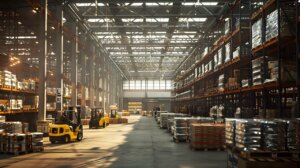
From Storage to Sustainability: How Warehousing Tech Makes Cities Greener
When you think about making cities more sustainable, warehouses probably aren’t the first thing that pops into your head.
Nonetheless, warehousing technology in Australia and around the world is helping make our cities greener, and it’s happening right before our eyes.
Sustainable technology and IoT are becoming an important part of improving our environment. They’re helping improve public transportation, reduce energy use, and more.
Today, we’ll discuss how smart warehouses are contributing to this change.
Why Does Warehousing Tech Matter for the Environment?
Online shopping is becoming increasingly popular, and e-commerce is experiencing significant growth. This means that more warehouses are being built.
And, as we build more warehouses, their influence grows. They impact our energy use, traffic congestion, and other aspects of daily life.
According to the World Economic Forum, the logistics sector is responsible for around 5.5% of global greenhouse gas emissions, with logistics buildings accounting for approximately 13% of that total.
McKinnon outlined that warehouse emissions account for around 20% of transport emissions in the US and between 11% and 30% in the UK.
That’s why it’s essential to create the right kind of warehouses.
Warehousing technology is transforming these spaces into smart, efficient, and green operations. Let’s explain how that works.
-
Smarter Energy Use
Firstly, technology is helping warehouses become more environmentally friendly by reducing energy consumption. New technologies, such as automated lighting, energy-efficient HVAC systems, and motion sensors, help ensure that warehouses only use power when needed.
Smart meters help monitor energy usage in real-time, helping these systems adjust quickly and become more efficient.
-
Using Greener Equipment
Inside warehouses, electric forklifts and automated guided vehicles (AGVs) are replacing machinery. These options help reduce greenhouse gas emissions and mitigate noise pollution, making them a win for both the environment and the community.
And it’s not just happening inside. Some companies are using electric delivery trucks, helping their products leave warehouses with a lower carbon footprint.
-
Optimized Space and Less Land Use
 Smart warehousing technology enables companies to scale their businesses without the need to create additional facilities. Solutions like automated storage and retrieval systems (AS/RS) and vertical storage solutions can help warehouses store more goods in less space.
Smart warehousing technology enables companies to scale their businesses without the need to create additional facilities. Solutions like automated storage and retrieval systems (AS/RS) and vertical storage solutions can help warehouses store more goods in less space.
As companies grow, they no longer require additional space and energy. They can invest in better solutions that increase their storage capacity. This helps preserve green spaces, use less land and energy, and is especially important for cities, where the lack of space is an issue.
-
Reduced Waste
Wasted goods mean wasted resources. Advanced inventory systems powered by AI and real-time data reduce product spoilage, overstocking, and unnecessary transportation.
For example, better tracking means perishable goods spend less time sitting around, which reduces food waste (a major contributor to landfill emissions). AI-driven demand forecasting also helps warehouses see which products are performing well and which aren’t. This helps them stock only what’s needed, reducing excess inventory that often goes to waste.
-
Smarter Location Choices
Technology helps companies choose warehouse locations more strategically. Building facilities closer to major transportation routes reduces the distance goods have to travel, saving on fuel.
This also helps reduce the traffic. Fewer delivery trucks on the road means less air pollution and improved quality of life.
-
Real-Time Data for Making Better Decisions
Digital technology has made warehouses more connected. Real-time data collection helps warehouse managers track energy use, equipment performance, and inventory levels at any given moment.
This constant stream of information helps identify problems, reduce waste, and implement improvements easily.
-
Supporting Worker Safety
 Automated guided vehicles (AGVs), robots, and conveyor systems handle all repetitive or hazardous tasks, reducing the likelihood of worker injuries and creating a more productive work environment.
Automated guided vehicles (AGVs), robots, and conveyor systems handle all repetitive or hazardous tasks, reducing the likelihood of worker injuries and creating a more productive work environment.
If warehouses utilize smart technology, such as sensors and smart cameras, it can help monitor the conditions within a warehouse. These devices alert managers to issues such as spills and equipment malfunctions, which allows them to respond promptly and prevent accidents from occurring.
Greener Warehouses Make Greener Cities
Making our cities more sustainable is a significant undertaking. Creating systems that support the environment while still focusing on improvement can make all the difference. Warehouses play a crucial role in these systems.
As more companies use smart warehousing technology, more cities can benefit from reduced emissions, less waste, and better land use.
Just imagine fewer trucks on the road, less air pollution, preserved green spaces, and reduced energy use. Warehouse technology may not be the first thing that comes to mind when you picture a greener city, but it can play an important role in creating one.